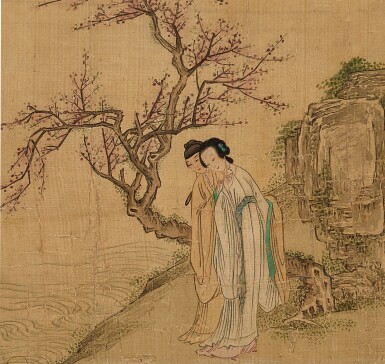Important Chinese Art including Jades from the De An Tang Collection and Gardens of Pleasure – Erotic Art from the Bertholet Collection
Important Chinese Art including Jades from the De An Tang Collection and Gardens of Pleasure – Erotic Art from the Bertholet Collection

Property from the Bertholet Collection 貝氏情色藝術珍藏
Wang Sheng (act. late 16th - early 17th century), Love Poems, Late Ming dynasty | 明末 王聲〈春宮詩意圖〉 一冊十開全 設色絹本 《吳郡王聲》款 「王」、「聲」印
Auction Closed
April 29, 06:28 AM GMT
Estimate
900,000 - 1,200,000 HKD
Lot Details
Description
Property from the Bertholet Collection
Wang Sheng (act. late 16th - early 17th century), Love Poems
Late Ming dynasty
貝氏情色藝術珍藏
明末 王聲〈春宮詩意圖〉 一冊十開全 設色絹本 《吳郡王聲》款 「王」、「聲」印
a complete album of 10 paintings with poems, ink and colour on silk
17 by 18 cm
Ferdinand M. Bertholet, Les Jardins du Plaisir: Érotisme et art dans la Chine ancienne / Gardens of Pleasure: Eroticism and Art in China, Paris, 2003 (rev. English ed., Munich, Berlin, London, New York, 2010), pp. 58-69.
Éva Patrícia Murakeözy, 'Ming. Emperors, Artists and Merchants in Ancient China', Journal of Eurasian Studies, October-December 2013, volume V, issue 4, p. 88.
貝索烈,《Les Jardins du Plaisir: Érotisme et art dans la Chine ancienne / Gardens of Pleasure: Eroticism and Art in China》,巴黎,2003年(英文再版,慕尼黑、柏林、倫敦、紐約,2010年),頁58-69
Éva Patrícia Murakeözy,〈Ming. Emperors, Artists and Merchants in Ancient China〉,《Journal of Eurasian Studies》,2013年10-12月,卷V,第4期,頁88
Meticulously painted with fine-tipped brushes, the slender, elegant figures are set against backdrops of naturalistically rendered gardens or pavilions highlighted by occasional bold brushstrokes. The figures are depicted as engaging in different stages of intimacy, from subtle seduction to total embrace, from full attire to complete exposure. However, the passion expressed by their actions contrasts markedly with a sense of timidity suggested by the reticent faces. Although not telling a continuous story, these scenes can be arranged according to the seasons, from spring to autumn.
It is extremely rare to find signed and dated Chinese erotic works, and this is possibly the earliest surviving example by an identifiable artist (James Cahill, ‘Les peintures érotiques chinoises de la collection Bertholet’, Le Palais du printemps, op. cit., p. 33). A collaborative effort, the present album comprises ten paintings of love scenes accompanied by ten poems written in various calligraphic styles. It echoes the Chinese scholarly tradition by underlining the connection between poetry, calligraphy, painting, and the artist’s seal.
The last leaf of illustration, the only homoerotic scene in the series, is signed Wang Sheng (active in the late 16th to early 17th century). According to Wusheng shi shi [The history of silent poetry], Wang, a native of Suzhou, was famous for his paintings of ladies with graceful and courteous figures at the end of the Ming dynasty. In addition to this album, a handful of paintings by Wang have been recorded, including one in the collection of the Palace Museum, Beijing (Zhongguo gudai shuhua tumu / Illustrated Catalogue of Selected Works of Ancient Chinese Painting and Calligraphy, vol. 21, Beijing, 2000, p. 319); and a signed hanging scroll depicting a scholarly gathering beneath peach blossom trees, sold in our New York rooms, 19th September 2013, lot 613.
Five of the poems are inscribed by Zhao Yong (studio name Changri) and two are dated to the winter of the yiwei year (1595), possibly the year when all the paintings were completed. The signatures of the remaining five poems read Shi Zhangquan, Ying Xingcai, Li Su, Yu Fuwen and Zhaoquan. Little, however, is known about these literati. For a translation of the ten poems, see Bertholet, Gardens of Pleasure, op. cit., pp. 59-69. Individual scenes and the corresponding poems are discussed in Le Palais du printemps, op. cit., pp. 50-69.
畫中情景描繪細緻,花園亭閣,細節自然,筆法纖纖,間以狂放筆觸相綴點題。人物姿態,或含蓄調情,或恣情歡愛,對比表情卻微帶羞澀,低歛保留。雖無直述連續情節,根據畫中細節,可知為春至秋季。
中國春宮繪畫,畫師鮮少署名,如此冊可溯源者,極為珍稀,此或為現知最早之例,參考高居翰,〈Les peintures érotiques chinoises de la collection Bertholet〉,《Le Palais du printemps》,前述出處,頁33。本冊頁十開繪畫,搭配十首詩詞,書體各異,呼應中國文人傳統,詩、書、畫、印合璧,纏綿之餘,不失雅韻。
冊頁最後一開,描繪同性之愛,署名王聲(十六世紀晚期至十七世紀早期),據《無聲詩史》,王氏,字遹駿,晚明蘇州人,擅畫仕女。本品之外,存世王聲之作,如北京故宮博物院藏品,錄於《中國古代書畫圖目》,卷21,北京,2000年,頁319。還有一署款〈桃溪高士〉軸,2013年9月19日售於紐約蘇富比,編號613。
其中五首詩為趙永所題,其二紀年乙未(1595年)冬,或為本冊頁完成之年。其他五首詩署名李素、肇銓、師章銓、應星采、于黼文,然關於他們的記錄稀缺。十首詩的翻譯可參考貝索烈,《Gardens of Pleasure: Eroticism and Art in China》,巴黎,2003年,頁59-69。各別詩圖相應之討論,參考高居翰等,《Le Palais du printemps》,前述出處,頁50-69。
